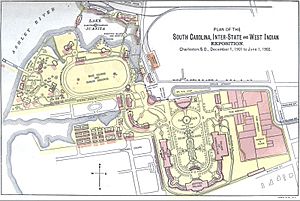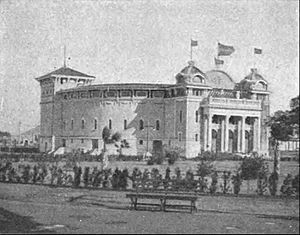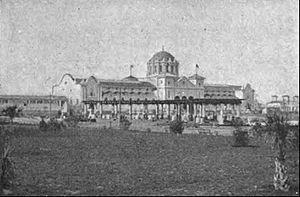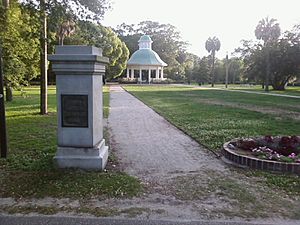South Carolina Inter-State and West Indian Exposition facts for kids
Quick facts for kids Charleston, South Carolina |
|
|---|---|
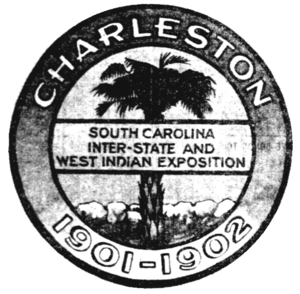 |
|
| Overview | |
| BIE-class | Universal expositon exposition |
| Name | South Carolina Inter-State and West Indian Exposition |
| Building | Cotton Palace |
| Area | 250 acres (100 hectares) |
| Visitors | 674,086 |
| Participant(s) | |
| Countries | 4 |
| Location | |
| Country | United States |
| City | Charleston, South Carolina |
| Timeline | |
| Opening | December 1, 1902 |
| Closure | June 20, 1902 |
| Specialized expositions | |
The South Carolina Inter-State and West Indian Exposition was a big fair held in Charleston, South Carolina. People often called it the Charleston Exposition or the West Indian Exposition. It was like a huge county fair and trade show for the region. The fair ran from December 1, 1901, to June 20, 1902.
Contents
Why Was the Exposition Held?
Charleston wanted to improve its trade with countries in Latin America and the Caribbean. Leaders saw how successful other fairs were, like the Cotton States and International Exposition in Atlanta, Georgia in 1895.
A railroad boss named J. H. Averill suggested holding a fair in Charleston. J. C. Hemphill, a newspaper editor, and Frederick W. Wagener, a local businessman, strongly supported the idea.
How the Fair Was Planned
In 1900, the Charleston Exposition Company was created. They started asking for money to fund the fair. Businesses and the South Carolina General Assembly (the state's government) gave money. However, some wealthy Charleston families did not support it.
The U.S. government usually helped fund such events, but they did not offer money at first. Also, no other countries officially had exhibits at the fair.
Wagener, who was in charge of the exposition company, offered 250 acres (about 101 hectares) of his land for the fair. This land was located along the Ashley River.
The company hired Bradford L. Gilbert, an architect from New York. He had worked on the Cotton States Exposition before. Gilbert designed the buildings in a Spanish Renaissance style. They were painted a creamy off-white color, which made the fairgrounds look like an "Ivory City."
Challenges Faced by the Exposition
The fair faced many difficulties. The weather was often bad, and some exhibits were not ready on time. There was also a shortage of money.
Even President Theodore Roosevelt had to delay his visit. He came in April instead of February. The number of visitors was lower than expected, with only 674,086 people attending.
The fair cost $1,250,000 to put on, but it only made $313,000. This meant it lost a lot of money.
What Could You See at the Fair?
The fairgrounds were split into two main areas: Nature and Art. The most important building was the Cotton Palace. It was 320 feet (98 meters) long and had a 75-foot (23-meter) tall dome.
Other major buildings included the Palace of Commerce and the Palace of Agriculture. The Woman's Building was located in Wagener's Lowndes Grove house. There were also buildings for Administration, Art, the Auditorium, Fisheries, Machinery, Mines and Forestry, Negro exhibits, Transportation, and Women.
Twenty different states took part in the exposition. States like Illinois, Maryland, Missouri, New York, and Pennsylvania built their own special buildings. Pennsylvania even showed the Liberty Bell in its exhibit! The cities of Cincinnati and Philadelphia also had buildings. Special structures were built for exhibits from Cuba, Puerto Rico, and Guatemala.
The fairgrounds also had many statues. Six original historical groups were placed in the Court of Palaces. These included "The Aztec," "The Negro," and "The Huguenot."
Fun and Games at the Midway
The midway was like a carnival. It had exciting rides and a huge 400-foot (122-meter) long painting of the Battle of Manassas. There was even an Eskimo village. You could also find a Turkish Parlor with imported cigars and a house of horrors.
A small miniature railroad was one of the most popular attractions. It took visitors to all the interesting spots, from the Sunken Gardens to the Court of Palaces.
Like other big fairs, the exposition sold many souvenirs. These included special medals, pins, and other small items to remember the event.
What Remains Today?
After the fair, Charleston created Hampton Park on part of the old fairgrounds. The bandstand from the Exposition was moved and rebuilt, and it is still in the park today.
In 1919, the state of South Carolina bought the western part of the land. This area became the new campus for The Citadel, a military college. The Lowndes Grove house, which was the Woman's Building during the fair, is also still standing.
Images for kids


